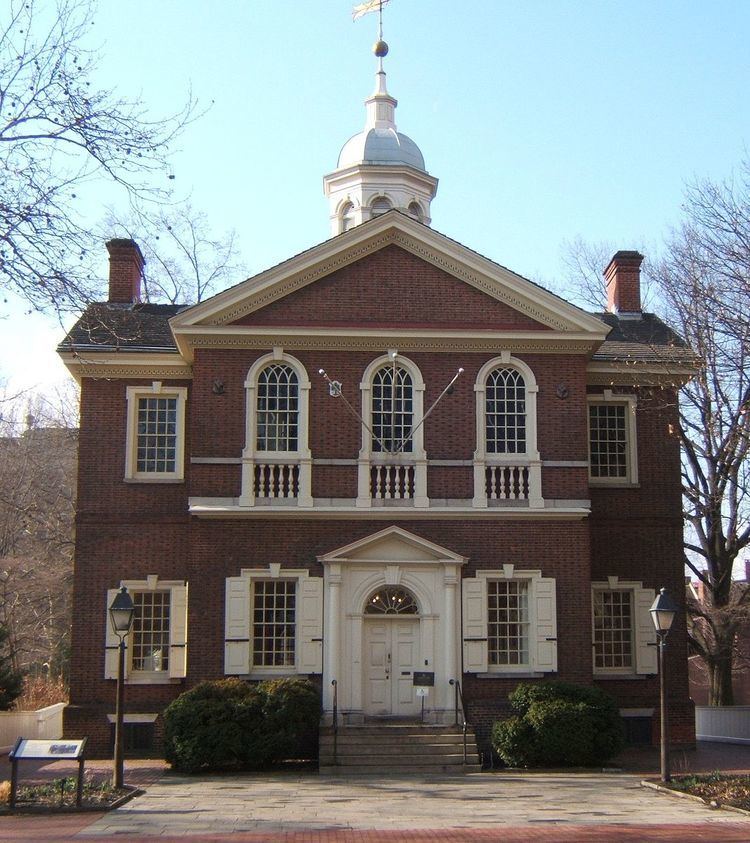Built 1770-1774 NRHP Reference # 70000552 Designated NHL April 15, 1970 Phone +1 215-925-0167 | Added to NRHP April 15, 1970 Opened 1770 | |
 | ||
Location 320 Chestnut StreetPhiladelphia, Pennsylvania Hours Closing soon · 10AM–4PMSaturday10AM–4PMSunday10AM–4PMMondayClosedTuesday10AM–4PMWednesday10AM–4PMThursday10AM–4PMFriday10AM–4PM Similar Independence National Historical, Independence Hall, Betsy Ross House, Christ Church - Philadelphia, Congress Hall | ||
Carpenters hall
Carpenters' Hall is a two-story brick building in the Old City neighborhood of Philadelphia, Pennsylvania, that was a key meeting place in the early history of the United States. Completed in 1775 and set back from Chestnut Street, the meeting hall was built for and is still owned by the Carpenters' Company of the City and County of Philadelphia, the country's oldest extant craft guild. The First Continental Congress met here. The building was added to the National Register of Historic Places on 15 April 1970 (#70000552) and is part of Independence National Historical Park.
Contents
Carpenters hall jamison cooper
History
Carpenters' Hall was designed by architect Robert Smith in the Georgian style based on both the town halls of Scotland, where Smith was born, and the villas of the Palladio in Italy. It would be first used as a meeting site by the guild on January 21, 1771, and would continue to hold annual meetings there until 1777 when the British captured Philadelphia. On April 23, 1773 (St. George's Day), it was used for the founding meeting of the Society of Englishmen and Sons of Englishmen.
The First Continental Congress of the United Colonies of North America met here from September 5 to October 26, 1774, since the Pennsylvania State House (Independence Hall) was being used by the moderate Provincial Assembly of Pennsylvania. It was here that Congress resolved to ban further imports of slaves and to discontinue the slave trade within the colonies, a step toward phasing out slavery in British North America. The building has a long history as an assembly place and has been the home to numerous tenants in the arts, sciences and commerce. The meeting hall served as a hospital for both British and American troops in the Revolutionary War, and other institutions in Philadelphia have held meetings in Carpenters' Hall, including Franklin's Library Company of Philadelphia, the American Philosophical Society, and the First and Second Banks of the United States. The federal Custom House in Philadelphia was located at Carpenter's Hall between 1802 and 1819, save for a brief interruption between January and April, 1811.
It was declared a National Historic Landmark in 1970.
Numerous dignitaries have visited Carpenters' Hall, including United States Supreme Court Chief Justice Warren Burger, King Carl XVI Gustaf and Queen Silvia of Sweden, President Václav Havel of the Czech Republic, President Guntis Ulmanis of Latvia, and Texas Governor (later U.S. President) George W. Bush with Pennsylvania Governor Tom Ridge.
Today, Carpenters' Hall is free to the public, visited annually by more than 150,000 tourists from around the world. The structure still serves the purpose for which it was built: a meeting place for the Carpenters' Company and union meetings.
Construction and design
The Carpenters Company was founded in 1724, but had no meeting house of their own, resorting to rented tavern rooms for their meetings. Carpenters Company members finally selected a new building site in 1768 on Chestnut Street, a few hundred feet from Benjamin Franklin's home. Robert Smith submitted the plans for the design, but did not supervise the construction of the hall. The decision to proceed with construction was made January 30, 1770. Construction was completed in August 1774.
